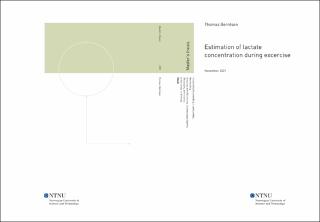Estimation of lactate concentration during excercise
Master thesis
Permanent lenke
https://hdl.handle.net/11250/2978560Utgivelsesdato
2021Metadata
Vis full innførselSamlinger
Sammendrag
Denne avhandlingen utforsker utviklingen of implementering av modeller og estimering av kontinuerlig laktat konsentrasjon hos utøvere under trening. Målet med en slik estimator er å bestemme laktakkonsentrasjonen hos en utøver. Når man trener er det viktig og styre intesiteten, dette kan gjøres ved å måle laktatkonsentrasjonen i blodet underveis i treningen. Dette krever dyrst utstyr og er ubehagelig å gjennomfør siden det kreves en blodprøve. For å gjøre intensitetstyring etter laktat mer tilgjengelig for folk søkes det derfor etter en billigere, mindre invasiv metode for å estimere laktatkonsentrasjonen under trening. This thesis explores the development and implementation of models and estimation of continuous lactate concentration in athletes during exercise. The goal of such a estimator is to accurately and reliably determine the lactate concentration of an athlete. When exercising it is important to keep the intensity under control, which can be done by measuring the lactate concentration in the blood intermittently during exercise. This requires expensive equipment and discomfort as a small blood sample is taken. To make lactate concentration a more widely accessible physiological marker, a cheaper, less intrusive method of estimating the lactate concentration is sought in this thesis.
To generate the data required for such an estimator, test protocols where designed and two test subjects went through the same set of testing days. The data was gathered, synchronised and organized for further use. A model based on physiological principals was chosen and simplified for use in a Kalman filter estimator. The Matlab implementation of this estimator yielded limited results as the data basis was not that large. A larger study with a larger data basis might yield results that are more applicable on other athletes.
Chapter 1 describes the motivation behind the problem, as well as the given problem description and approach. Chapter 2 introduces the essential theoretical background for the methods described in Chapter 3. Chapter 4 contains all the results from both the data gathering process as well as estimations with different inputs. In Chapter 5 these results are discussed and summarized.
